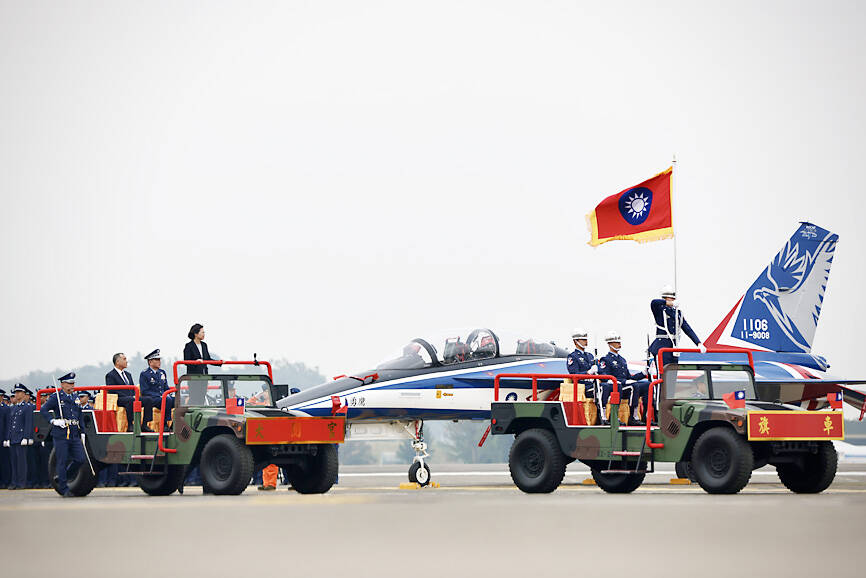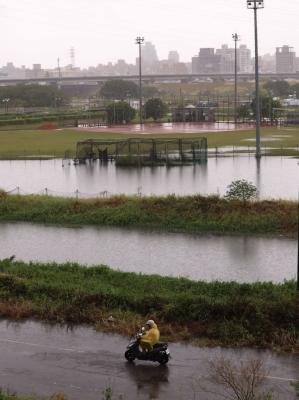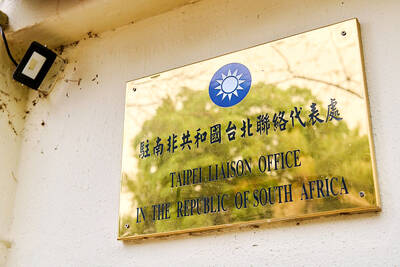President Tsai Ing-wen (蔡英文) yesterday visited the Air Force Flight Training Command at Kaohsiung’s Gangshan Air Base in a bid to bolster the nation’s capability to train fighter pilots.
The command’s upgrade from being an Air Force Academy subordinate to a headquarters under the service came a day after the Taitung-based 7th Flight Training Wing was reflagged as the 7th Tactical Fighter Wing.
The creation of the training unit would speed up the nation’s combat pilot training and qualification process, Tsai said during an inspection, adding that the command is expected to function seamlessly with the academy sharing the same base.

Photo: RITCHIE B. TONGO, EPA-EFE
The Flight Training Command’s founding marks a new epoch in the air force’s pilot training program, switching from utilizing three aircraft types, Beechcraft T-34, AIDC AT-3 and F-5 trainers, to a two-stage one utilizing Beechcraft T-34s and AIDC T-5 Brave Eagles, the service said.
Brave Eagles — the indigenous developed advanced trainer jet — would provide a better training platform for pilots expected to handle modern high-performance military aircraft being introduced, including the Lockheed Martin F-16V, it said.
Decreasing the number of trainer aircraft types will enable a reduction in valuable instruction time spent on familiarizing trainees across three distinct platforms, air force flight instructor Major Wang Tzu-hung (王次宏) said.
The focus of the flight training program is to produce a sufficient number of trainers with dual qualifications as instructors and fighter pilots, Air Force Lieutenant Colonel Huang Wen-hsuan (黃文軒), a trainer of trainers, said.
The new fighter pilot training program would see pilots initially receive training on foundational flight skills, formation flying and basic air maneuvers in T-34s, then transition to T-5s for interception and advanced air combat maneuvers, he said.
The air force has seven combatant wings utilizing AIDC F-CK-1s, Dassault Mirage 2000s and Lockheed Martin F-16 jets in addition to Flight Training Command and Songshan Air Base Command, which operates the presidential airplane.

Taipei, New Taipei City, Keelung and Taoyuan would issue a decision at 8pm on whether to cancel work and school tomorrow due to forecasted heavy rain, Keelung Mayor Hsieh Kuo-liang (謝國樑) said today. Hsieh told reporters that absent some pressing reason, the four northern cities would announce the decision jointly at 8pm. Keelung is expected to receive between 300mm and 490mm of rain in the period from 2pm today through 2pm tomorrow, Central Weather Administration data showed. Keelung City Government regulations stipulate that school and work can be canceled if rain totals in mountainous or low-elevation areas are forecast to exceed 350mm in

EVA Airways president Sun Chia-ming (孫嘉明) and other senior executives yesterday bowed in apology over the death of a flight attendant, saying the company has begun improving its health-reporting, review and work coordination mechanisms. “We promise to handle this matter with the utmost responsibility to ensure safer and healthier working conditions for all EVA Air employees,” Sun said. The flight attendant, a woman surnamed Sun (孫), died on Friday last week of undisclosed causes shortly after returning from a work assignment in Milan, Italy, the airline said. Chinese-language media reported that the woman fell ill working on a Taipei-to-Milan flight on Sept. 22

COUNTERMEASURE: Taiwan was to implement controls for 47 tech products bound for South Africa after the latter downgraded and renamed Taipei’s ‘de facto’ offices The Ministry of Foreign Affairs is still reviewing a new agreement proposed by the South African government last month to regulate the status of reciprocal representative offices, Minister of Foreign Affairs Lin Chia-lung (林佳龍) said yesterday. Asked about the latest developments in a year-long controversy over Taiwan’s de facto representative office in South Africa, Lin during a legislative session said that the ministry was consulting with legal experts on the proposed new agreement. While the new proposal offers Taiwan greater flexibility, the ministry does not find it acceptable, Lin said without elaborating. The ministry is still open to resuming retaliatory measures against South

1.4nm WAFERS: While TSMC is gearing up to expand its overseas production, it would also continue to invest in Taiwan, company chairman and CEO C.C. Wei said Taiwan Semiconductor Manufacturing Co (TSMC) has applied for permission to construct a new plant in the Central Taiwan Science Park (中部科學園區), which it would use for the production of new high-speed wafers, the National Science and Technology Council said yesterday. The council, which supervises three major science parks in Taiwan, confirmed that the Central Taiwan Science Park Bureau had received an application on Friday from TSMC, the world’s largest contract chipmaker, to commence work on the new A14 fab. A14 technology, a 1.4 nanometer (nm) process, is designed to drive artificial intelligence transformation by enabling faster computing and greater power